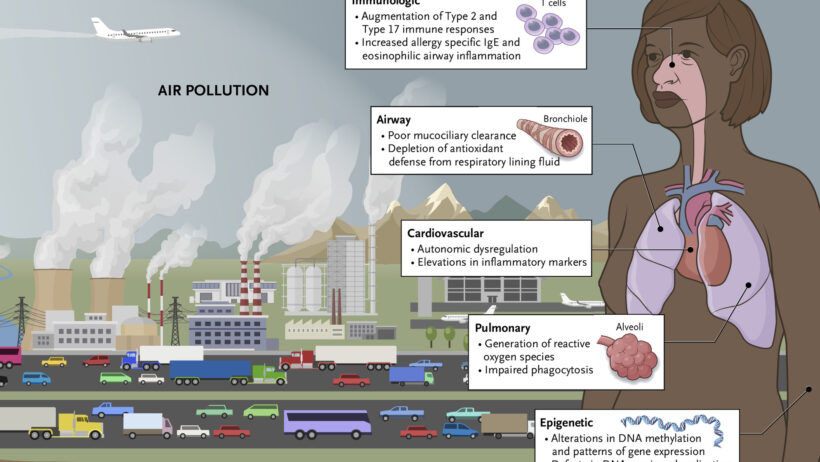The relationship between global warming and air pollution is not merely a matter of environmental science; it underscores a pressing public health crisis that extends beyond the visible horizon. While many individuals perceive air pollution as an immediate threat, often linked to industrial smoke or vehicle emissions, a more insidious aspect emerges when one observes the interaction between climate change and air quality. It is imperative to unpack how rising global temperatures catalyze a cascade of air pollutants, leading to deleterious health outcomes that silently afflict populations worldwide.
As the planet warms, a host of meteorological changes occur, one of which is the enhancement of ground-level ozone concentrations. Ozone is a secondary pollutant formed when sunlight interacts with pollutants such as nitrogen oxides and volatile organic compounds. Warmer temperatures amplify the photochemical reactions that lead to the formation of this harmful gas, which can trigger respiratory problems, exacerbate asthma, and contribute to cardiovascular diseases. Enthralling is the correlation between temperature and air quality, which elucidates why regions that experience higher temperatures often face escalating smog issues.
Moreover, wildfires, increasingly fueled by climate change, add another layer of complexity to the air pollution narrative. The frequency and intensity of wildfires have surged in recent years, particularly in regions prone to drought. These infernos emit particulate matter and a barrage of toxic substances into the atmosphere, leading to what researchers term hazardous air quality. This phenomenon is not localized; smoke can traverse vast distances, impacting air quality hundreds of miles away. The fallout is particularly perilous for vulnerable populations, including the elderly, children, and those with pre-existing health conditions.
An equally critical yet often understated component of this discourse is the contribution of particulate matter (PM) from other sources exacerbated by climate change. PM, particularly PM2.5, poses significant health risks as these minute particles can penetrate deep into the respiratory system, leading to chronic illnesses and premature mortality. As global temperatures rise, dust storms—a consequence of drought conditions—have become more frequent, releasing massive quantities of PM into the atmosphere. This phenomenon juxtaposes the macro effects of climate change with intricate mechanisms that directly harm human health.
The economic implications of this public health crisis are staggering. Increased hospital visits, medicine prescriptions, and long-term healthcare costs associated with pollution-related illnesses place an immense burden on both individual and societal levels. As air quality deteriorates, so too do the productivity and effective functioning of communities, with lost workdays and decreased performance compounding the challenges posed by climate change. The invisible nature of this threat often belies its severity, sparking a paradox where health risks remain unrecognized until they manifest in dramatic and tragic ways.
Addressing the relationship between global warming and air pollution is not solely an ecological endeavor; it demands a comprehensive approach that encompasses public policy, community engagement, and technological innovation. Transitioning towards renewable energy sources is a pivotal strategy to mitigate emissions that contribute to both climate change and air pollution. Solar, wind, and hydropower alternatives offer the promise of cleaner air and reduced greenhouse gas emissions. However, the path is fraught with challenges as transitioning energy systems necessitates holistic policies that address the socioeconomic implications of such changes.
This conversation also extends into urban planning and public transportation. Cities present unique challenges, as high population densities correlate with increased vehicle emissions, thus exacerbating air quality issues. Strategically designed urban spaces that prioritize walkability and public transit can substantially ameliorate pollution levels. Electric vehicles, while gaining traction, need supportive infrastructure to be fully realized. If cities can pivot toward sustainable practices, they will not only tackle air pollution but also curtail the rate of global warming.
As the impacts of climate change become increasingly localized and visceral, the need for community awareness and activism becomes ever more urgent. Grassroots movements are essential in driving awareness about the health impacts of air pollution stemming from climate change. Citizen engagement can incite changes at the governmental level, fostering policies conducive to better air quality and climate action. Such initiatives epitomize the notion that public pressure can lead to significant legislative reforms, catalyzing a cultural shift towards sustainability.
In conclusion, the nexus between global warming and air pollution is emblematic of an invisible threat that looms over humanity. While the effects of climate change manifest visibly in the form of extreme weather events, the subtler yet equally damaging consequences of air pollution cannot be overlooked. As we grapple with these interlinked crises, it is vital to embrace a multifaceted approach—redesigning energy systems, urban environments, and public health policies. The time to act is now, and the urgency of this challenge cannot be overstated. By acknowledging and addressing the connections between climate change and air pollution, we can pave the way for healthier populations and a more sustainable planet.







